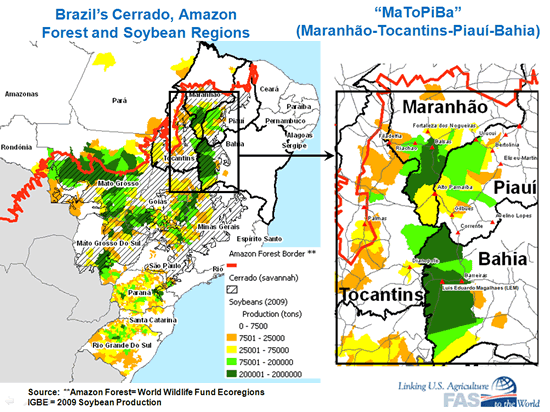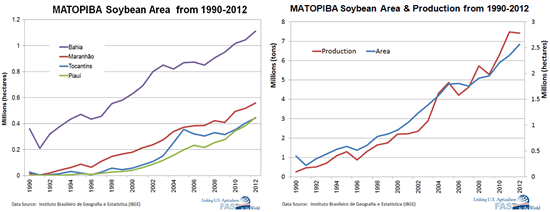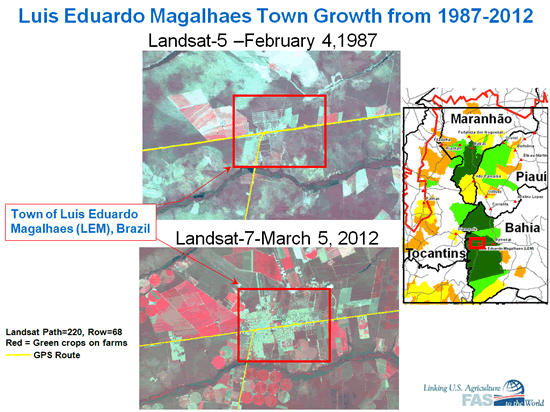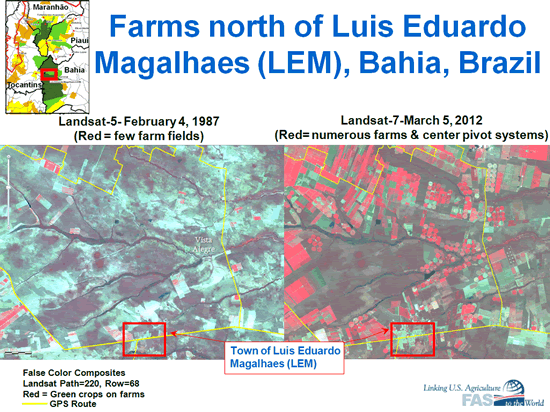Brazil’s Latest Agriculture Frontier in Western Bahia and MATOPIBA
Brazil’s new agriculture frontier is commonly called “MATOPIBA”, where soybean production during 2011/12 reached 7.5 million tons, or more than 10 percent of Brazil’s total soybean production of 65.5 MT. MATOPIBA is an acronym that uses the first two letters of the four states where soybean production is expanding into southern Maranhão (MA), Tocantins (TO), southern Piauí (PI), and western Bahia (BA) (refer to Figure 1). Agriculture expansion is occurring in the MATOPIBA region where cheap land prices within the cerrado (or savannah) have close proximity to the coastline and the region is not landlocked like the neighboring and top soybean-producing state of Mato Grosso. In addition, most of the cropland expansion in MATOPIBA is occurring in the cerrado (or savannah) and not occurring within the Amazon Forest, as occurred in Mato Grosso.

Figure 1. MATOBIPA is Brazil’s new agriculture frontier
Soybean area and production in MATOPIBA has increased during the past 20-years, and western Bahia is the state where most soybeans are grown (refer to graphs in Figure 2). Soybean yields reached 3.36 tons/hectare last year for the state of Bahia, which tied the southern state of Parana for the highest soybean yields in the country in 2011. However, infrastructure is still lagging behind soybean production growth, with major regional infrastructure improvements required for the region, including better roads, rails, storage facilities and ports.

Figure 2. MATOPIBA Soybean Area and Production
Many of the new farmers in the MATOPIBA region come from southern Brazil, who bring capital and agriculture expertise for opening up the cerrado (or savannah) lands. New farms in the MATOPIBA region tend to have low yields during the first couple of years but many of these farms later achieve some of the highest yields in the country after the soils are treated with fertilizer, lime, and gypsum for several years and grow soybeans, corn, or cotton in rotation.
The town of Luis Eduardo Malaghaes (LEM) is the center of western Bahia’s soybean production, and farms and irrigation systems continue to be developed in the region. Landsat satellite imagery in Figures 3 and 4 show LEM as a small town with only a few fields surrounding the town in 1987. But 25 years later, Landsat imagery in 2012 show numerous farms and numerous center pivot systems located along the alluvial banks of rivers and streams. Farms continue to grow in the LEM region, with several farms in 2012 reported to be larger than 100,000 hectares in size. Center pivot irrigation systems are also increasing in the LEM and MATOPIBA regions, which help to provide a reliable supply of water, increase yields, and provide double cropping potential. When irrigation is available in western Bahia, soybeans tend to be the first crop planted, followed by corn or cotton.

Figure 3. Urban growth at Luis Eduardo Magalhaes (LEM), Bahia, Brazil from 1987 to 2012.

Figure 4. Farm expansion in the LEM region from 1987 to 2012,
with numerous center pivot irrigation systems located along the stream banks.
Related articles:
Brazil’s Frontier Regions: Western Bahia
Opening Cerrado Land
Current USDA area and production estimates for grains and other agricultural commodities are available on IPAD's Agricultural Production page or at PSD Online.
|

